Kastamonu
Kastamonu, formerly Kastamone (Greek: Κασταμονή) or Kastra Komnenon (Greek: Κάστρα Κομνηνών), is a city in northern Turkey. It is the seat of Kastamonu Province and Kastamonu District.[2] Its population is 125,622 (2021).[1] The city lies at an elevation of 904 m (2,966 ft). It is located in the southern part of the province.
Kastamonu | |
|---|---|
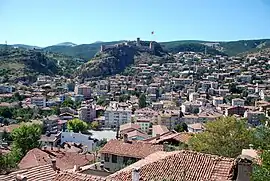 | |
 Flag 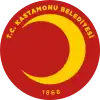 Coat of arms | |
 Kastamonu Location in Turkey | |
| Coordinates: 41°22′35″N 33°46′35″E | |
| Country | Turkey |
| Province | Kastamonu |
| District | Kastamonu |
| Government | |
| • Mayor | Galip Vidinlioğlu (MHP) |
| Elevation | 904 m (2,966 ft) |
| Population (2021)[1] | 125,622 |
| Time zone | TRT (UTC+3) |
| Area code | 0366 |
| Climate | Dfb |
| Website | www |
History

.jpg.webp)
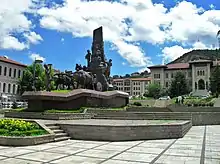
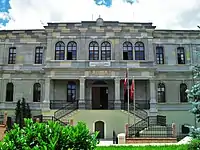
The city is believed to have been founded in the 18th century BC. The town was known as Timonion (Τιμόνιον in Greek) during the Roman period.
The change of name of the town dates to the tenth century AD. Manuel Erotikos Komnenos, a prominent general and the father of the Byzantine emperor Isaac I Komnenos, was given lands around the city by Emperor Basil II and built a fortress there named Kastra Komnenon (Κάστρα Κομνηνῶν). Manuel came to the notice of Basil II because of his defence, in 978, of Nicaea against the rebel Bardas Skleros.[3] The name Kastra Komnenon was shortened to Kastamone, and later Turkified to Kastamoni and Kastamonu.
Ibn Battuta visited the city, noting it as "one of the largest and finest cities, where commodities are abundant and prices low." He stayed here forty days.[4]
The famous Sufi saint of the city is Sheikh Shaban Veli (Şaban-ı Veli in Turkish, d. 976 AH/1569 AD).[5][6]
The Dress Code Revolution of Mustafa Kemal Pasha started on August 23, 1925, at Kastamonu. Atatürk made his historical speech concerning the "Hat and Dress Revolution" during his visit to Kastamonu in 1925 in the Republican People's Party building.[7] The building is now used as the Archeological Museum of Kastamonu. The possessions used by Mustafa Kamal in his Kastamonu visit are also exhibited in the museum.
Cuisine
Typical country fare in Kastamonu includes a quick rose petal jam made with sugared water, citric acid and gül mayası - the latter is a preparation of culinary-grade rose petals with sugar and citric acid that preserves them and brings out their flavor and fragrance. Homemade hot sauce is made by simmering grated tomato, garlic, Turkish red pepper, hot peppers, sunflower oil, salt and pepper on the stove. Sweet katmer is made by preparing a simple unleavened dough of flour, salt and water that is smeared with a tahini and sunflower oil mixture as it is folded.[8]
Breakfast might include farm made cheese, olives, pekmez, fried potatoes, rose jam homemade hot sauce, eggs served hot in the pan (called sahanda yumurta), folded unleavened bread called katmer, fresh farm milk and black tea.[8]
A speciality of Taşköprü, Kastamonu is freshly slaughtered whole lamb slow-cooked over the glowing embers of wood in a sealed, airtight "well" — this regional specialty is called kuyu kebabı in Turkish. A little water added to a tray ensures that steam keeps the meat moist throughout the cooking process.[8]
Produces around 200 tons of pastırma each year, çemen is made using garlic that is locally produced by the farming villages of Taşköprü.[[9]]
Education
Kastamonu is home to Kastamonu University, which was established in 2006 by incorporating existing colleges, schools, and institutes that were previously under Ankara University and Gazi University. Notable high schools in Kastamonu are: Abdurrahman Paşa Lisesi, also known as Kastamonu Lisesi, the first modern high school that was established in Anatolia in late Ottoman Empire. Kastamonu Mustafa Kaya Lisesi, an Anatolian high school, one of the most successful high schools in Turkey outside Istanbul, Ankara and Izmir.
Geography
The town consists of 20 quarters: Kuzeykent, Mehmet Akif Ersoy, Yavuz Selim, Budamış, Akmescit, Aktekke, Atabeygazi, Beyçelebi, Cebrail, Hepkebirler, Hisarardı, Honsalar, Inönü, Isfendiyar, Ismailbey, Kırkçeşme, Saraçlar, Topçuoğlu, Esentepe and Candaroğulları.[11]
Climate
Kastamonu has a humid continental climate (Köppen: Dfb, Trewartha: Dc) with cold winters and warm summers. Precipitation is evenly distributed throughout the year, with a noticeable increase during spring.
| Climate data for Kastamonu (1991–2020, extremes 1930–2020) | |||||||||||||
|---|---|---|---|---|---|---|---|---|---|---|---|---|---|
| Month | Jan | Feb | Mar | Apr | May | Jun | Jul | Aug | Sep | Oct | Nov | Dec | Year |
| Record high °C (°F) | 17.3 (63.1) |
21.1 (70.0) |
27.8 (82.0) |
31.4 (88.5) |
35.1 (95.2) |
37.5 (99.5) |
42.2 (108.0) |
40.2 (104.4) |
39.3 (102.7) |
32.5 (90.5) |
24.7 (76.5) |
21.1 (70.0) |
42.2 (108.0) |
| Average high °C (°F) | 3.6 (38.5) |
6.9 (44.4) |
11.5 (52.7) |
17.0 (62.6) |
21.7 (71.1) |
25.3 (77.5) |
28.8 (83.8) |
29.1 (84.4) |
24.6 (76.3) |
18.7 (65.7) |
11.2 (52.2) |
4.8 (40.6) |
16.9 (62.4) |
| Daily mean °C (°F) | −0.6 (30.9) |
1.1 (34.0) |
4.8 (40.6) |
9.5 (49.1) |
14.2 (57.6) |
17.7 (63.9) |
20.5 (68.9) |
20.5 (68.9) |
16.2 (61.2) |
11.2 (52.2) |
4.9 (40.8) |
0.7 (33.3) |
10.1 (50.2) |
| Average low °C (°F) | −3.8 (25.2) |
−3.1 (26.4) |
−0.4 (31.3) |
3.4 (38.1) |
7.7 (45.9) |
11.0 (51.8) |
13.0 (55.4) |
13.1 (55.6) |
9.5 (49.1) |
5.9 (42.6) |
0.5 (32.9) |
−2.4 (27.7) |
4.5 (40.1) |
| Record low °C (°F) | −26.9 (−16.4) |
−22.3 (−8.1) |
−19.7 (−3.5) |
−8.5 (16.7) |
−3.6 (25.5) |
0.2 (32.4) |
3.8 (38.8) |
0.9 (33.6) |
−1.5 (29.3) |
−7.5 (18.5) |
−19.3 (−2.7) |
−23.7 (−10.7) |
−26.9 (−16.4) |
| Average precipitation mm (inches) | 29.4 (1.16) |
28.1 (1.11) |
38.5 (1.52) |
50.5 (1.99) |
77.9 (3.07) |
89.6 (3.53) |
36.0 (1.42) |
38.2 (1.50) |
38.7 (1.52) |
34.8 (1.37) |
27.5 (1.08) |
36.1 (1.42) |
525.3 (20.68) |
| Average precipitation days | 11.20 | 10.30 | 11.87 | 13.13 | 15.23 | 12.70 | 6.90 | 6.53 | 7.37 | 9.87 | 8.97 | 11.37 | 125.4 |
| Mean monthly sunshine hours | 62.0 | 96.1 | 127.1 | 162.0 | 198.4 | 222.0 | 272.8 | 266.6 | 192.0 | 148.8 | 105.0 | 55.8 | 1,908.6 |
| Mean daily sunshine hours | 2.0 | 3.4 | 4.1 | 5.4 | 6.4 | 7.4 | 8.8 | 8.6 | 6.4 | 4.8 | 3.5 | 1.8 | 5.2 |
| Source: Turkish State Meteorological Service[12] | |||||||||||||
Transport
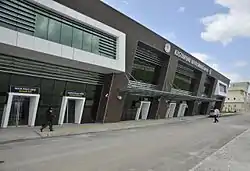
The main bus station has bus links to most major Turkish cities. Kastamonu Airport is active. Kastamonu is also the main railroad endpoint for the West Black Sea region.
Notable natives
- Latifî (1491-1582), Ottoman poet
- Iovan Tsaous (Yiannis Eitziridis) (1893–1942), Greek musician and composer
- Oğuz Atay (1934–1977), novelist
- Rıfat Ilgaz (1911–1993), novelist
- Halit Akmansü (1883–1953), military officer in the Ottoman and Turkish armies
Gallery
_-_panoramio.jpg.webp) City center
City center Kastamonu school building
Kastamonu school building Kastamonu University
Kastamonu University Historic Turkish houses
Historic Turkish houses A türbe (tomb)
A türbe (tomb)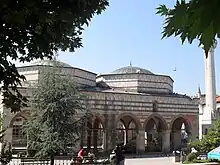

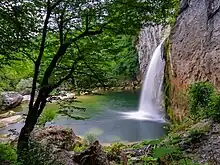








See also
- List of clock towers - Kastamonu has its own Ottoman clock tower (1885)
- Paphlagonia
Notes
- "Address-based population registration system (ADNKS) results dated 31 December 2021" (XLS) (in Turkish). TÜİK. Retrieved 1 March 2023.
- İl Belediyesi, Turkey Civil Administration Departments Inventory. Retrieved 1 March 2023.
- Runciman, pp. 54-55
- Battutah, Ibn (2002). The Travels of Ibn Battutah. London: Picador. p. 117. ISBN 9780330418799.
- "ŞÂBÂN-ı VELÎ - TDV İslâm Ansiklopedisi". islamansiklopedisi.org.tr (in Turkish). Retrieved 2020-09-11.
- Laluask: Şaban-ı Veli
- İğdemir, Uluğ (1963). Atatürk. Mango, Andrew (trans.). Ankara: Turkish National Commission for UNESCO. pp. 165–170. OCLC 75604149.
- Lezzet Haritası - Kastamonu /29 Kasım. Show TV. Retrieved 2018-07-30.
- Tarım TV. Sarımsağı kadar pastırması da ünlü. Archived from the original on 2018-07-31. Retrieved 2018-07-31.
- Prothero, G.W. (1920). Anatolia. London: H.M. Stationery Office. p. 106.
- Mahalle, Turkey Civil Administration Departments Inventory. Retrieved 1 March 2023.
- "Resmi İstatistikler: İllerimize Ait Mevism Normalleri (1991–2020)" (in Turkish). Turkish State Meteorological Service. Retrieved 24 April 2021.
References
- Runciman, Steven (1951) A History of the Crusades, Vol. I: The First Crusade, Cambridge University Press.